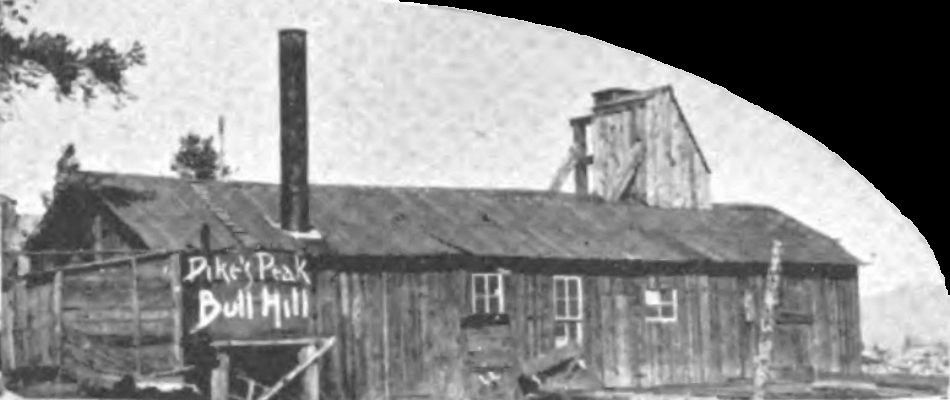-> My Collection; No source to show as I've not shared the Mining Journal as an album.
But, here is a link to first page on Hathi Trust Digital Library website.
October, 1896 (page 105->110)
Source had no images, only several sketches/drawings, so I used some images from my collection.
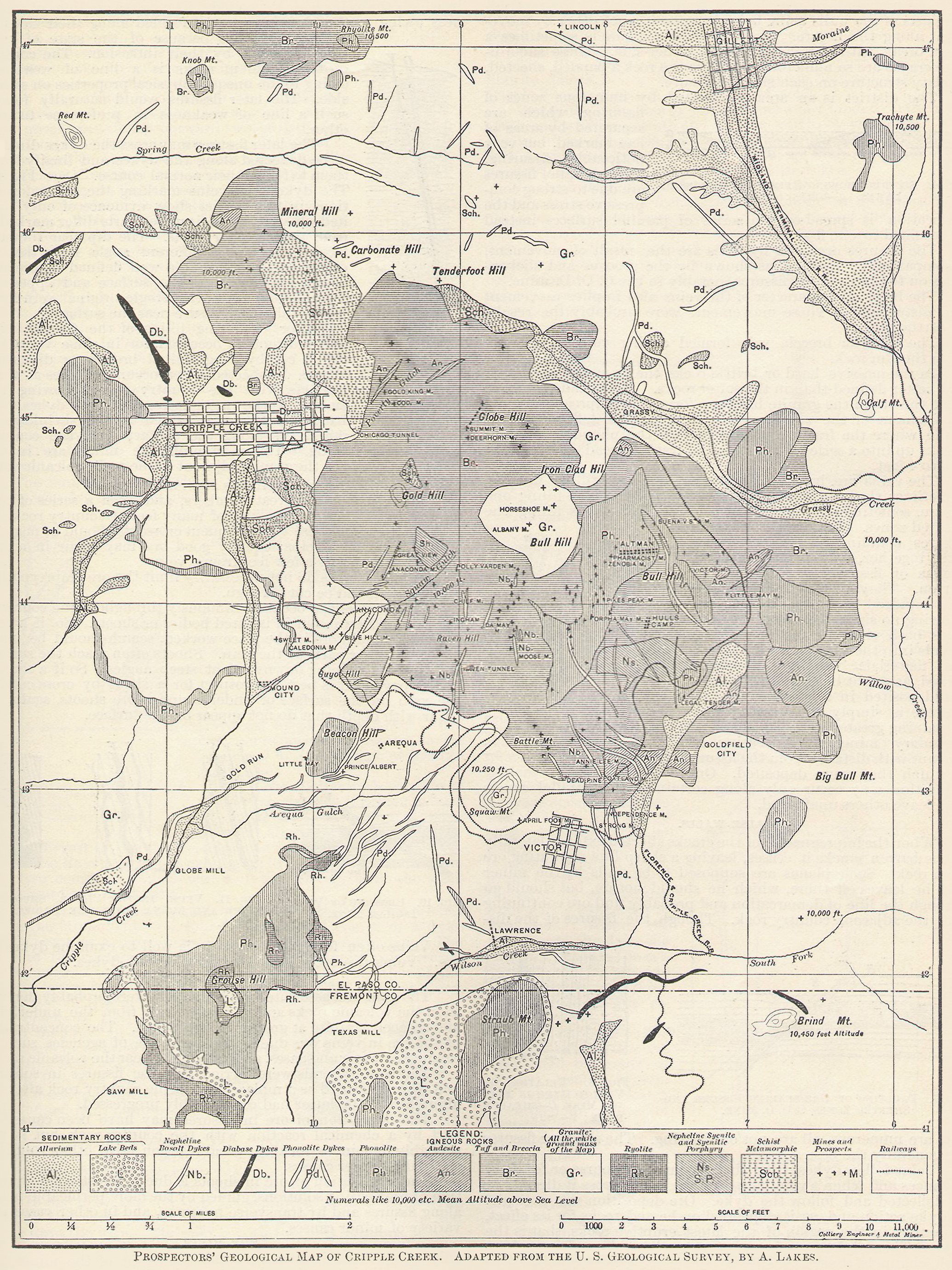
PROSPECTORS' GEOLOGICAL MAP OF CRIPPLE CREEK. ADAPTED FROM THE U. S. GEOLOGICAL SURVEY, BY A. LAKES.
Open map in New Window
Although much has been written in the past on the geology and ore deposits of Cripple Creek, both in THE COLLIERY ENGINEER AND METAL MINER and elsewhere, the subject is by no means exhausted, and we believe the following simplified epitome of the latest elaborate and complete report by Messrs. Cross and Penrose will be welcomed by miners and prospectors who may not have access to the works of the Geological Survey and who wish to be thoroughly informed on all that is knowable about this greatest gold camp of the West.
Apart from its local character, the report throws great light on the question of the formation and origin of ore deposits in general and is an excellent lesson on this subject.
GEOLOGY—THE CRIPPLE CREEK VOLCANO.
The igneous rocks of the district are actually in, or close to, the volcanic vent from which they came. The evidences of true volcanic activity are:
1st—Concentration of different kinds of volcanic phenomena around a very small center.
2nd—The fragmental character of the lava suggests only a volcanic origin.
3rd—The relation between this fragmental material and the massive granite shows directly the place of the throat of the volcano.
4th—The phonolite occurrences indicate the position of the central vent.
The sequence of events at this center embraces several periods of explosive outbursts alternating with quiet eruptions. In the dying out period, fumarole and solfataric, i. e., steam and hot-spring, action either succeeded several of the eruptions of molten matter or else were especially active in the earlier part of the closing period of eruptions.
Hot waters, containing chemical agents in solution, decomposed and altered the rocks about the center, and ore deposit, which is mainly confined to the region of decomposition, was a later phase of the action of permeating solutions.
CHARACTER OF THE LAVAS.
The fragmental materials, that is the tuffs and breccias, occupy a larger space than the massive igneous rocks and these materials had once a greater extent than at present. The texture is fine grained and without bedding, implying that the fragments were comminuted by repeated explosions from a vent or by very violent ones. Some of the tuffs are beautifully banded with concentric rings of red or purple.
The andesite lava composing the andesitic fragmental breccia is shown in some places as a purplish rock with distinct white crystals of feldspar in it. Generally speaking the rock is so decomposed and bleached that the original andesitic character of the material is not recognizable.
Of the phonolite, Dr. Cross thinks there may have been two distinct vents in the period of the volcano, one near Anaconda, the other northeast of Battle Mt. The phonolite is commonly recognized by its pale greenish gray color and by its schistose or slaty character. A granite breccia made of fine fragments of granite occurs locally, implying that the earliest explosive outbreak was so violent as to shatter the granite into sand and gravel. The High Park beds may represent a lake into which these showers of granite debris fell.
LOCATING THE CRATER.
The actual crater walls of the volcano, judging from the steep dip of the contact plane between lava and granite, may have been between Squaw Mt. across Arequa gulch and through Guyot hill to Anaconda. The granite is much broken or brecciated along this line of contact. Massive phonolite dykes are locally found much fractured in places as if by some earthquake shock attendant on the explosions. The whole district is much shattered and greatly fissured, sometimes the latter with much regularity, producing sheeted zones, the favorite lines for ore deposition. The granite bordering around the central zone is much broken as if by similar causes.
The massive lavas erupted by the volcano were trachytic phonolite, a greenish drab gray generally slaty rock.
Nepheline syenite occurs only in one spot which appears to be the location of the crater on the spur of Bull hill south of the Independence town site. Andesite occurs both in flows and dykes and some of the dykes seem to have occurred long after the first flow of lava.
True phonolite was erupted at several periods in the volcanic activity.
Nepheline basalt in small dykes was erupted quite late in the volcanoe's history and often forms the matrix of the ore of some of the principal mines, as the Anna Lee, Black Diamond, Moose, Raven, Ben Harrison and others.
The earliest eruptions were of andesite followed by phonolite and closed later by small basaltic dyke eruptions. These dykes are particularly numerous in the vicinity of Battle Mt. and Raven hill, and suggest by their congregating there that that was the site of the crater. Some of the phonolite dykes also appear to radiate towards a given center. As the latter rock contains sulphuric acid, chlorine and fluorine, it suggests the strong gaseous emanations that occurred at the time of the eruption or later. Fluorine appears to have been the principal gas of the fumarole period. Abundant heated watery solutions circulated also through the much fractured rocks. Both the earlier decomposition and ore deposition belonged within the general epoch of the volcanic action, and after them came an expiring outbreak of explosive forces, as shown by a peculiar vent of tuff in the Moose mine associated with ore bodies, which shows that a small and comparatively late vent is located at that spot.
HISTORY OF THE VOLCANO.
The sequence of phenomena at this center of eruption was that typical of a volcano. The earliest event was an explosive outburst through the granite, forming the hole through which the volcanic forces relieved themselves in many subsequent periods. A volcanic channel may be formed originally by a violent explosion, not necessarily followed at once by ejection of igneous molten matter, repeated explosive outbreaks being necessary to completely clear the throat of country rock fragments; hence, the scarcity of granitic fragments in the lava breccia. There appears to have been a series of eruptions of various lavas alternating with explosive outbursts. With few exceptions the rocks do not represent lava streams; lava flows, however, issuing from the dykes have been eroded away. Volcanic eruptions in this area appear to have continued, with intervals of quiet, from the close of the Cretaceous down to late Tertiary times.
DESCRIPTION OF THE MINING AREA.
The breccia of Anaconda ridge at the Anaconda mine is cut by dykes of andesite, one of which shows distinct crystals of white feldspar and black crystals of augite and hornblend.
Battle Mt. is mainly formed of fine grained volcanic breccia and tuff cut by numerous dykes of andesite, phonolite and basalt. On the west the volcanic rocks are bounded by the granite contact. Near Victor is a local vent exposed in a railroad cut in the granite just west of the town.
Big Bull Mt. is mostly of granite, with a few patches and dykes of andesite and phonolite. A few veins occur in the granite, marking fault-lines.
Bull Cliff, where the strikers had their fort, is a cliff of a dyke of columnar phonolite.
Bull Hill proper consists of granite and a large mass of trachytic phonolite, in which the principal masses occur on its eastern slope. There are also numerous dykes of basalt and phonolite.
Globe and Ironclad hills are formed exclusively of tuff and breccia.
Gold Hill is of fine grained breccia. In Anaconda ridge are several dykes of andesite and some syenite porphyry. As the schist occasionally outcrops from beneath the breccia in Globe Hill the breccia here fills in hollows of a very rugged granite and schist topography.
In Grouse Mountain are remnants of a rhyolite flow not connected with the Cripple Creek volcano.
Guyot Hill is made up of breccia cut by phonolite dikes.
At Mineral Hill, north of the town, a mass of breccia extends up the slope and forms its summit, filling a north and south depression in granite and schist. The reservoir is excavated in fragmental material consisting of granite in subangular and rounded blocks together with andesite and breccia which shows a rude bedding structure as of rearranged material. This is probably a remnant of a small local lake deposit.
Poverty Gulch and Tenderfoot Hill show a contact line of the breccia with the granite and schist.
The coarse grained Pike's Peak granite occupies all the area north, east and south of the volcanic center. The finer grained granite occurs in dykes in this.
A marked sheeting of granite and gneiss by numerous parallel fissures occurs in many parts of the district, trending north and south. These fissures are intimately connected with the orebearing veins.
Rhyolite mountain is really composed of phonolite ; the same may be said of Knob Mt. and Mt. Pisgah. Phonolite occurs in enclosed dykes and irregular necks in granite, the latter well shown on Straub Mt. It is probable that some of the phonolite dykes flattened out horizontally, beneath the base of the original volcanic cone, owing to superincumbent pressure. The dyke may be from only 15 feet wide all the way to 100 feet. The top of Beacon Hill consists of a phonolite dyke and there are several small dykes near the Prince Albert and Gold Dollar mines. The crest of Grouse Mt. is also of phonolite from a large dyke and many similar but smaller dykes occur on the ridge between Grouse and Squaw Mt.
On Grouse Mt. are curious conglomerate beds formed of granitic detritus by Miocene lakes, probably derived from the early explosions of the volcano.
MINES AND ORE DEPOSITS.
The ore deposits are almost exclusively gold bearing. The ores consist of country rock impregnated with and replaced by quartz, fluorite, opaline silica and kaolin, with iron pyrites, manganese oxides, rarely galena, with small quantities of malachite, zinc, and with native gold, oxidized tellurium, gypsum and calcite. Zinc and copper are very rare.
A characteristic ore is a mass of quartz and purple fluorite. The gold occurs in the ore as free gold, as telluride of gold, and as gold-bearing iron pyrites. The gold in the placer deposits and a part of that in the vein, is in the form of free gold. In the veins, free gold occurs mostly in the upper parts of the ore bodies, but within a depth of 100 feet the telluride of gold associated with iron pyrites appears and takes the place of free gold.
A few mines have been sunk several hundred feet on ore carrying free gold. In such case, the vein minerals are in a very oxidized condition. It is evident that the free gold was derived from oxidation of tellurium and pyrite. The free gold occurs in thin angular plates, like gold obtained by dissolving other metals from a gold alloy. It is both coarse and fine, in grains, plates or spongy masses, generally coated with a rusty film. The gold is remarkably pure containing scarcely any silver. The form of the tellurium may be either that of calaverite or sylvanite. Iron pyrites occurs both in the veins and in the country rock. In the upper portions it is converted into brown iron oxide. Manganese oxide is also very common. Quartz occurs in various forms, sometimes disseminated through the ore, making it hard, sometimes in thin bands honeycombing the rock or forming well defined veins or cementing fragments of rock. It may be crystalline, massive or mammillary. With fluorite, it makes purple quartz. It is also opaline, and a hydrous form of silica of a white, buff brown, or red color called "jasper" occurs and forms a common vein material. A soft white clay derived from decomposition of the granite and eruptive rocks, called "talc" by the miners, is kaolin or china clay. Gypsum occurs in the Deerhorn mine. The surface rocks as well as veins are much oxidized, and this action of surface waters may descend to 300 or 400 feet in cases.
The value of the ores varies from a few dollars to several thousands per ton. Most of the ore shipped varies from $20 or $30 to $300 or $400. The average of all ore is between $50 and $85 per ton. Some mines ship no ore less than $100 per ton. Some average over $200. It is a high grade camp.
MODE OF OCCURRENCE OF ORES.
The ores occur in fissures in the country rock representing slight faulting. The veins intersect all rocks, and have been formed by a replacement along the fissures, and not by filling of open gaps.
The region of eruptive rocks covering the granite is about 3 miles long north and south, and 2,5 wide east and west, comprising 7 square miles.
From late Cretaceous into Tertiary times, eruptive outbreaks were frequent in the Rocky mountains, and lavas are found from Canada to Mexico. The area now occupied by Cripple Creek is the site of a volcanic vent. The region was originally entirely of granite, like that of Pike's Peak; but in the volcanic period a series of vents was the scene of explosive eruptions ejecting quantities of fragmental rock, forming the breccias and tuffs now covering the region. At the end of the eruption the vents were filled and choked up with this same breccia. So the region is underlaid partly by granite and partly by the filled up vent.
This breccia was later penetrated by numerous volcanic dykes passing through both granite and breccia. They were the last signs of eruptive activity, and their appearance is evidence of the epoch of fissuring, which lasted long after the dyke action had ceased. They are from a few inches to many feet in width, and sometimes intersect each other, showing they are of different dates. Some of these dykes below ground become thin and terminate abruptly, leaving a crack or fissure in the rock as the extension of their course. Fissures were sometimes formed along the course of the dykes after their intrusion, at others, evidently before the dykes. Dykes fork and follow diverging fissures; their direction is generally northeast to northwest. The existence of dykes implies pre-existence of fissures.
Such fissuring took place during the whole eruptive activity. Veins may occupy these early fissures, but generally the vein fissures were not the earliest ones. In the breccia area they are sharp breaks with minute parallel sheeting formed in comparatively compact rocks. The breccia originally was soft, but since converted into a hard rock. Sharp fissures and sheeting could not have been formed when it was a soft rock, but after the rock had been altered and hardened.
Some vein fissures are intersected by dykes intruded before the deposition of ore. Generally the fissures occupied by veins were formed after the intrusion of the dykes, and were prevalent all over the district, extending far into the granite regions surrounding it. Later fissures follow the course of pro-existing fissures, since they intersect the dykes longitudinally; elsewhere they cross the previous fissures at various angles. Sometimes a later fissure follows the course of pre-existing fissures in a transverse direction. It alternately follows and crosses the older fissuring. (See plate 3).
The region is much broken by numerous fissures intersecting one another at various angles. One general course is usually prominent. The fissures are very numerous, and in the underground workings are intersected every few feet.
These fissures were not open gaps, but almost closed lines of fracture, and the veins in them are a replacement of the country rocks along these courses. Sometimes the fissures were held open by loose fragments of rock broken from the walls or by protruding parts of the walls being brought opposite each other by movement along the fissure. The course of a fissure is sometimes a clean break with parallel cracks on either side. These subordinate cracks are so numerous as to give the rock a banded, sheeted, or slaty structure on each side the fissure.
The district is an area intersected by numerous zones of fissuring, which are separated by areas of less marked, but very noticeable fissuring. These parallel fissures are due to strong compressive stress and the dislocation is spread over a series of parallel surfaces instead of confined to one fissure.
The fissures occupied by veins are the result of movement, accompanied by faulting, as shown by the grooves and slickensides on the faces of the fissures, notably in the C. O. D. mine.
The brecciated character of the veins also implies movement and disturbance. These movements were probably the results of earthquakes.
The granitic breccia was formed during volcanic activity from the rim rock.
In the massive hard or brittle rocks the fissures are sharper and better defined than in the softer rocks. In the Independence mine the ore in the granite has been formed by impregnation and replacement of the country rock along a well defined fissure, while where the fracture passes through the phonolite dyke it breaks up into a series of thin parallel cracks spread over a width of 3 to 4 feet.
The veins are bodies of secondary minerals filling fissures. Sometimes they are single, well defined bodies of ore filling one fissure, sometimes in numerous thin parallel seams filling the fissured zones. Two parallel zones of fissures containing ore may occur close together, separated by isolated breaks or fissures carrying ore, or barren. They are followed down several hundred feet by the miners, showing no signs of exhaustion. Ore lines both sides of the fissure and blends into the country rock beyond, but materials are promiscuously mixed, as might be expected, by ores not deposited in a free open fissure. The ore is simply the country rock containing greater or less quanties of secondary minerals, decreasing in amount with distance from the fissure in which they were deposited. Ore deposition may occur only along certain of the parallel cracks and leave others unaffected.
FALSE WALLS.
When the impregnation of the cracks affected extends laterally to the barren cracks it ceases, leaving a sharp line separating ore from rock. Such planes are supposed to be walls by the miner and he leaves off there, which he should not do, but should go through the line of demarcation and probably find ore continuing into the adjacent country rock. Though the fissures of the district are numerous, all are not ore bearing. The stronger fissures are generally the best.
Veins follow dykes either throughout their course or for short distances and when a vein meets a dyke it may cross it directly or be deflected and follow the dyke. Ore deposition was a sequel of dyke action and, as it depended on heated rocks for its effect, it occurred in the region of the latest eruptive rocks, that is the dykes.
These dykes may have cut water channels, and water from such channels, thus forced up the sides of the dykes, may have caused ore deposition. Shrinkage cracks formed in the dykes at their contacts with the country rock offered favorable places for ore deposition. The dykes directed the courses of the later fissures in which the veins were deposited. The dykes are lines of weakness owing to the shrinkage cracks formed along their sides in cooling and also because of the state of tension produced by their intrusion. The contact of two different rocks is a line of weakness owing to the unequal physical properties on either side. The later fissures would naturally follow such a line of weakness in preference to any other.
The later fissures may cross the dykes directly or be deflected along the dykes and finally leave them to follow their normal course. (See Fig. 4.) The dykes and veins marking the latest formations in the district show evidence of only limited erosion, for their upper parts differ markedly from their deeper parts. The dip near the surface is often at a different angle from that at depth, and occuring in a well defined fissure at a depth, may fork near the surface and appear in separate outcrops, the single original vein forking by relief of pressure near the surface.
After or during filling of the fissures with ore, movements occurred, for in some veins the ore is cut by longitudinal breaks or distorted. Cracks or sheeted zones occur in dykes at their contacts with the country rock following the curves in the meanderings of the dykes. A banded structure is caused by the shrinkage of the dykes along the contact with the country rock during cooling. The most profitable mines are in the eruptive rocks or in the granite adjacent to the main volcanic vent.
HINTS FOR MINERS AND PROSPECTORS.
The veins occur in great numbers, and often a series of parallel veins extends over a width of many feet of country rock.
In mining on these veins frequent crosscuts should be made in search of parallel veins; equally good ore may occur in a vein parallel to and only a few feet from a vein.
Supposed walls do not necessarily limit the ore impregnation and these should be cut through.
Pay ore does not occur continuously throughout the course of the vein or fissure, but in isolated bodies or shoots. So, if a vein does not contain ore in the place worked, search should be made for ore in other parts of the vein. Shoots often reach the surface and outcrop, dipping downward at steep angles.
So if a shaft is not on pay ore it is best to prospect for a shoot by cross cutting the vein on the surface or underground. Ore shoots, again, do occur with depth that do not appear on the surface.
Veins often follow dykes, so it is well to examine dykes for ore. Veins also occur near to or parallel with dykes.
ORIGIN OF ORE DEPOSITS.
The gold and associated vein minerals were probably derived from the volcanic rocks and to a less extent from the underlying and adjacent granite at greater or less depth. The concentration of the ore in veins was due to the influence of agencies such as steam, hot water and gases, generated in or near the volcanic rocks.
The vein minerals were carried into the fissures in solution and were deposited as a replacement of the country rock after the alteration of the latter had considerably progressed.
The deposition of ore in fissures may have been caused in part by a chemical reaction with the country rock, but it was probably due more to a chemical reaction with other solutions assisted by other causes.
The localization of ore in shoots is due to a restricted circulation of ore bearing solutions, guided by the more permeable places along fissures and by transverse fractures, and in other cases to a variety of minor causes.
THE MINES.
We do not propose to give a full account of the mines, but only of such as illustrate certain peculiar characteristics and exceptionally interesting phenomena.
The country rock of the C. O. D. mine in Poverty gulch is an andesitic breccia much altered, and, at a depth below surface influences, hard and compact.
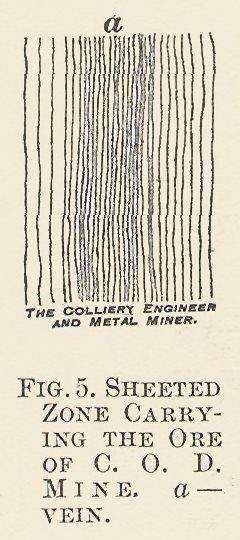
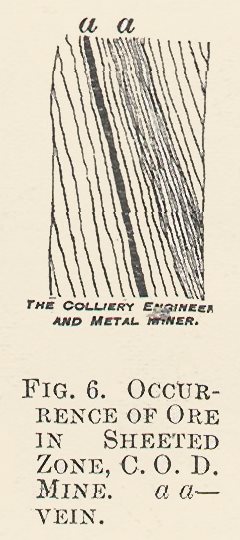
The ore occupies a well defined fault fissure with distinct slickensides on the walls and with numerous subordinate cracks on either side the main fissure. These are so numerous as to give the rocks a distinctly slaty structure in which the cracks are sometimes only a fraction of an inch apart. This structure extends outward two or three feet on either side the main fissure till the cracks become farther apart and less distinct and finally disappear. This structure is due to intense compression along the line of fissure. See Figs. 5 and 6.
The main fissure is slightly faulted, the throw being only a few inches. The faults occurred before the deposition of the ore, for the latter is not cut off by them, but follows the line of fault. The ore occurs along the main fissure and in smaller cracks on either side. It consists of the country rock impregnated and partly replaced by quartz, purple fluorite, iron pyrites, and iron oxide and other materials in smaller quantities, among which is telluride of gold, calaverite. Red clay and fragments of country rock occur in the ore. The ore averages over $100 a ton.
It occurs in a well defined shoot and has been continuous from the surface down. It represents a part of the fissure where an unusual amount of ore deposition has occurred. The course of the waters depositing the ore was influenced by the cross fissures.
The Summit and Deerhorn mines are in an area of breccia cut by massive rocks which has been much fissured and broken. This disturbance has given every facility for the percolation of heated waters. By this the rocks are greatly altered, softened and impregnated with ore, depositions of quartz, fluorite, etc. Fine grained gypsum is found in the vein at depth with fluorite. Sometimes the veins are short and lenticular or else continuous and varying in width from a few inches to several feet.
In the Anaconda the principal vein follows along a dyke.
Squaw Mt. is of coarse granite traversed by phonolite dykes. The ore occurs mostly in fissures in the granite or at the contact of granite with dykes.
The Blue Bell mine is peculiar as containing galena, zincblende and silver, as well as gold. A large quantity of water was struck in the vein, sufficient to run the Sylvanite and Rosebud stamp mills.
In the Raven mine the ore occurs in an independent fissure, but often comes in contact with a dyke. It represents the neck of a fumarole or hot spring.
In the Ingham mine a system of fissures crosses the main fissure.
In the Moose, the vein follows the general course of a dyke which occupies a much fissured zone in the country rock. The ore is at the contact of the dyke with the country rock breccia, and sometimes occurs on one side, sometimes on the other of the dyke in layers from an inch to a foot in thickness, while at times the center of the dyke contains ore in joint cracks so that the whole dyke is mined for ore.
In the North Star the ore occurs in a series of parallel fissures pervading both dyke and wall rock.
On Bull Hill most of the veins are in the massive eruptive rocks occupying well defined fault fissures independently of dykes.
The Victor, Smuggler, Lee and Buena Vista are on the same vein, which is sometimes a clean break, at others a series of parallel fissures. The rock of the vein is trachytic phonolite. In one place the vein has been faulted 20 feet, and a dyke occupies the fault place. Iron oxide, iron pyrite, fluorite and jasper form the vein. The gold is both free and in telluride.
The ore of the Pharmacist, which is a fissure vein, is country rock replaced by clear glassy quartz with pyrite and kaolin. The vein is sometimes brecciated and full of rock fragments.
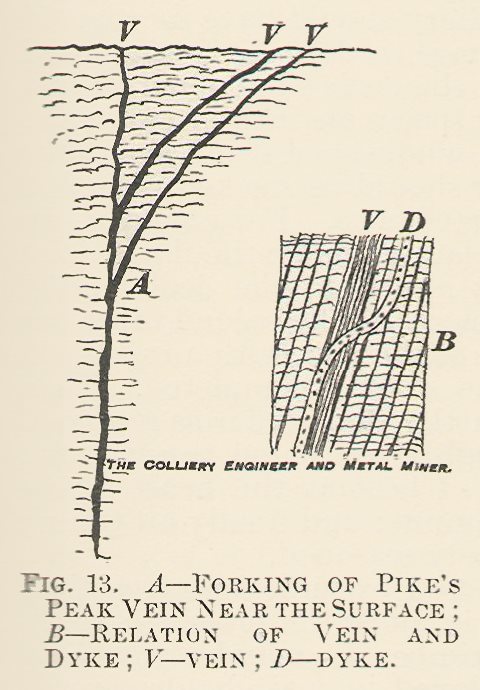
FIG. 13. A—FORKING OF PIKE'S PEAK VEIN NEAR THE SURFACE ; B—RELATION OF VEIN AND DYKE ; V—VEIN ; D—DYKE.
The Pike's Peak is on a vein in a zone of fissuring, the country rock being intersected by numerous parallel fissures in which is much red clay derived from the wall rocks. Thin dykes of phonolite, from an inch to 18 inches, occur in the fissured zone. While at depth the ore occurs in one vein, near the surface it forks and outcrops in three separate veins. (See Fig. 13.)
The Blue Bird mine is noted for the quantities of purple fluorite quartz in the vein, which may or may not carry gold. Purple fluorite quartz is no sure sign of gold.
Battle Mt. is an area of volcanic rocks surrounded on the east, south and west by granite and on the north by volcanoes. The mountain is of breccia, intersected by numerous dykes, cutting both breccia and granite. The veins occur both in fissures independent of dykes and also connected with dykes.

FIG. 15. SURFACE PLANS AND VERTICAL SECTIONS OF THE INDEPENDENCE MINE, SHOWING THE RELATIONS OF THE VEINS TO THE DYKES.
In the Independence the ore follows the course of a phonolite dyke from three to six feet thick, sometimes close up against it, at others several feet away, and at times it crosses the dyke from side to side. The ore as developed in the granite occupies a well defined fissure with parallel cracks on either side. The ore is sometimes confined to the rock, which has been replaced along both sides of the one main fissure, but often it impregnates the subordinate cracks giving a width of 1 to 15 feet. The ore is an impregnation and replacement of the granite along the fissures.
There are no well defined walls, the ore on the sides simply blending into the country rock. Where the vein crosses the dyke the character of the fissure is changed. Instead of the ore occurring mostly along or on both sides of a principal fissure it occurs in a great number of faint parallel cracks, no one of which is especially defined. But as soon as the vein reaches the granite on the other side of the dyke it again assumes its normal condition.
The ore of the Independence mine consists of granite from which the mica and quartz have been partly or wholly removed, leaving a honeycombed vesicular mass of partially kaolinized feldspar, in which the cavities have been later filled by secondary quartz with more or less iron pyrites, a little fluorite and other minerals among which is telluride of gold. In such a porous material, surface waters have had a free channel for their percolation, and the iron pyrites is largely oxidized down to the lower levels, while the telluride of gold has been partly converted to free gold. Where the vein crosses the dyke the gold still exists in the telluride form. This is one of the richest and most noted mines in the region.
The Portland mine is on an area of breccia intersected by numerous parallel fissures several feet apart but closely assembled in zones of fissuring in which they are only a fraction of an inch apart. A dyke passes along this fissured area and is itself fissured. The principal workings are on three main veins; two on the breccia and one on the dyke.
The workings of the Anna Lee mine are on a chimney-shaped body of ore of a cylindrical form, 12 to 15 feet diameter, dipping vertically from the surface to the bottom of the mine. The ore body occurs in the course of a dyke 2 to 4 feet wide and much fissured. The ore body consists of a part of the dyke and breccia much kaolinized and impregnated with quartz, iron pyrite, etc. Sometimes kaolin fills the cracks of the rock, at others it cements a few unaltered parts or it has kaolinized the whole rock. The ore body represents the neck of a hot spring. The ascending hot waters kaolinized the feldspathic constituents of the rock and deposited the other minerals forming a column or body of ore. The ore body is connected with one or more of the fissures common in the neighborhood.
Both the Lawrence and Gillette areas are on granite which has been fissured and intersected by dykes like the rest.
The Lincoln mine is located on two intersecting fissures.
On Spring Creek most of the veins are in granite or dykes in granite. Some of these veins carry galena and silver as well as gold in the eruptive red granite.
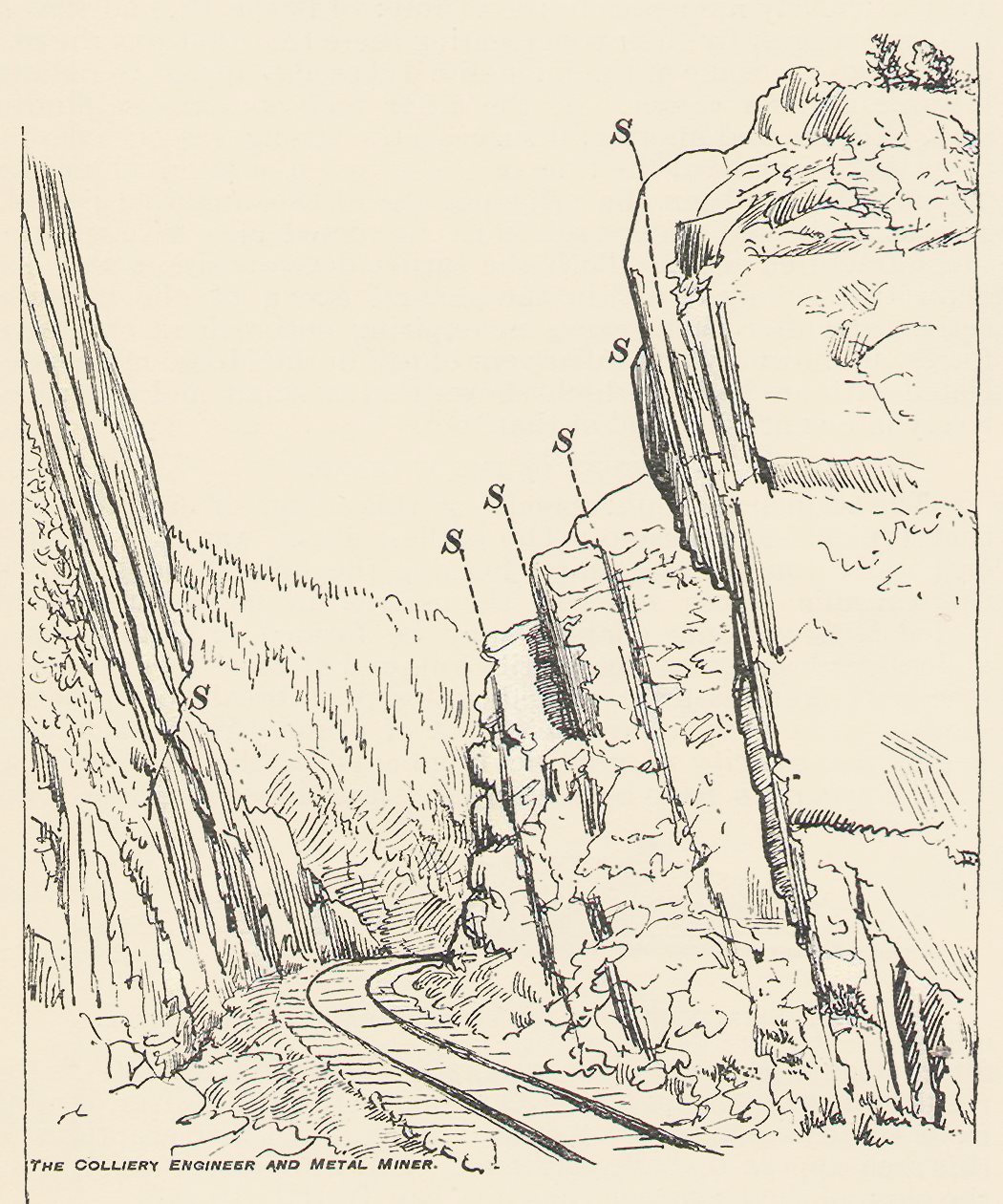
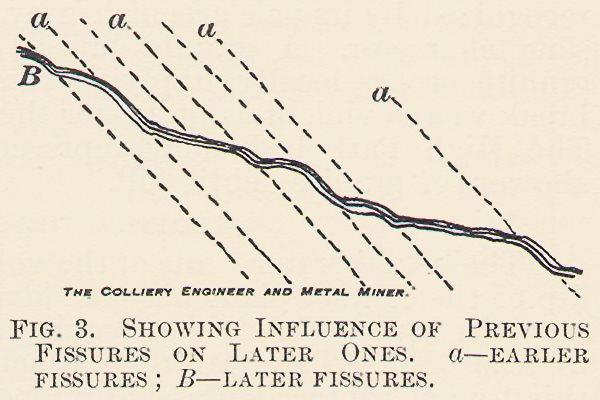
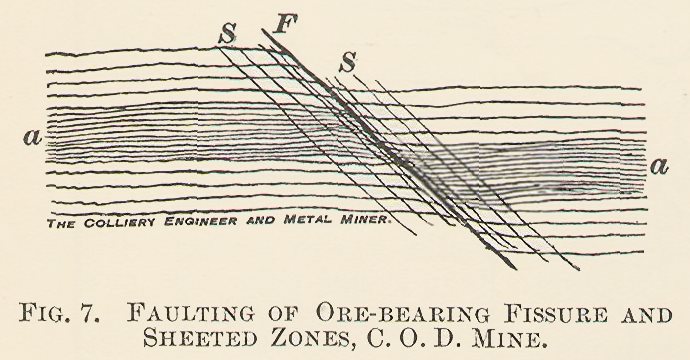
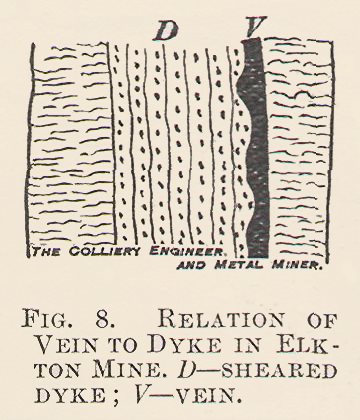


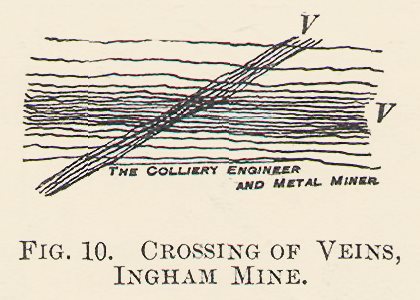
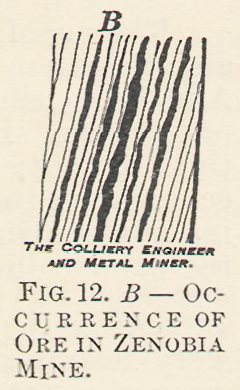
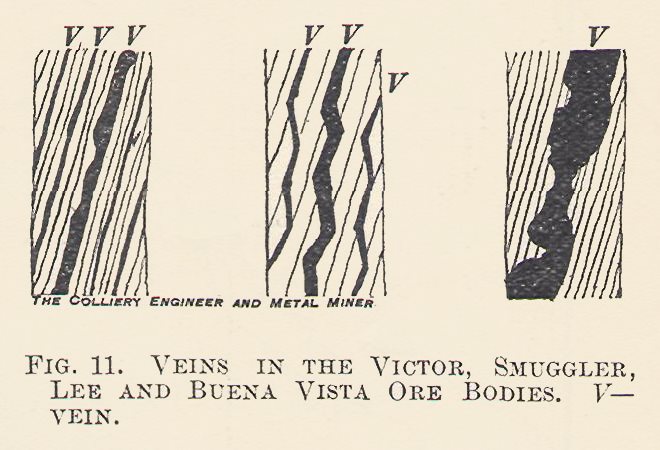
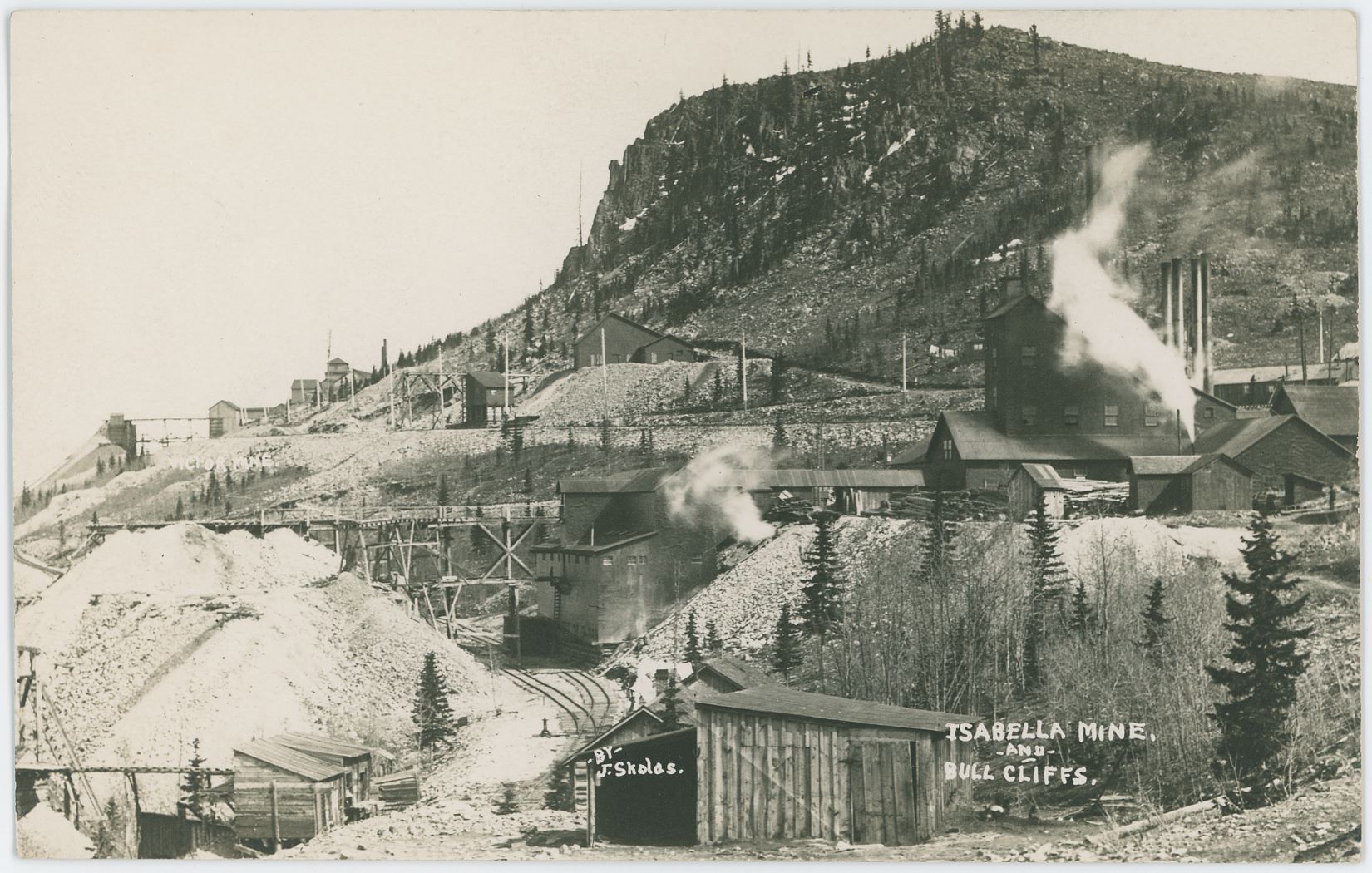
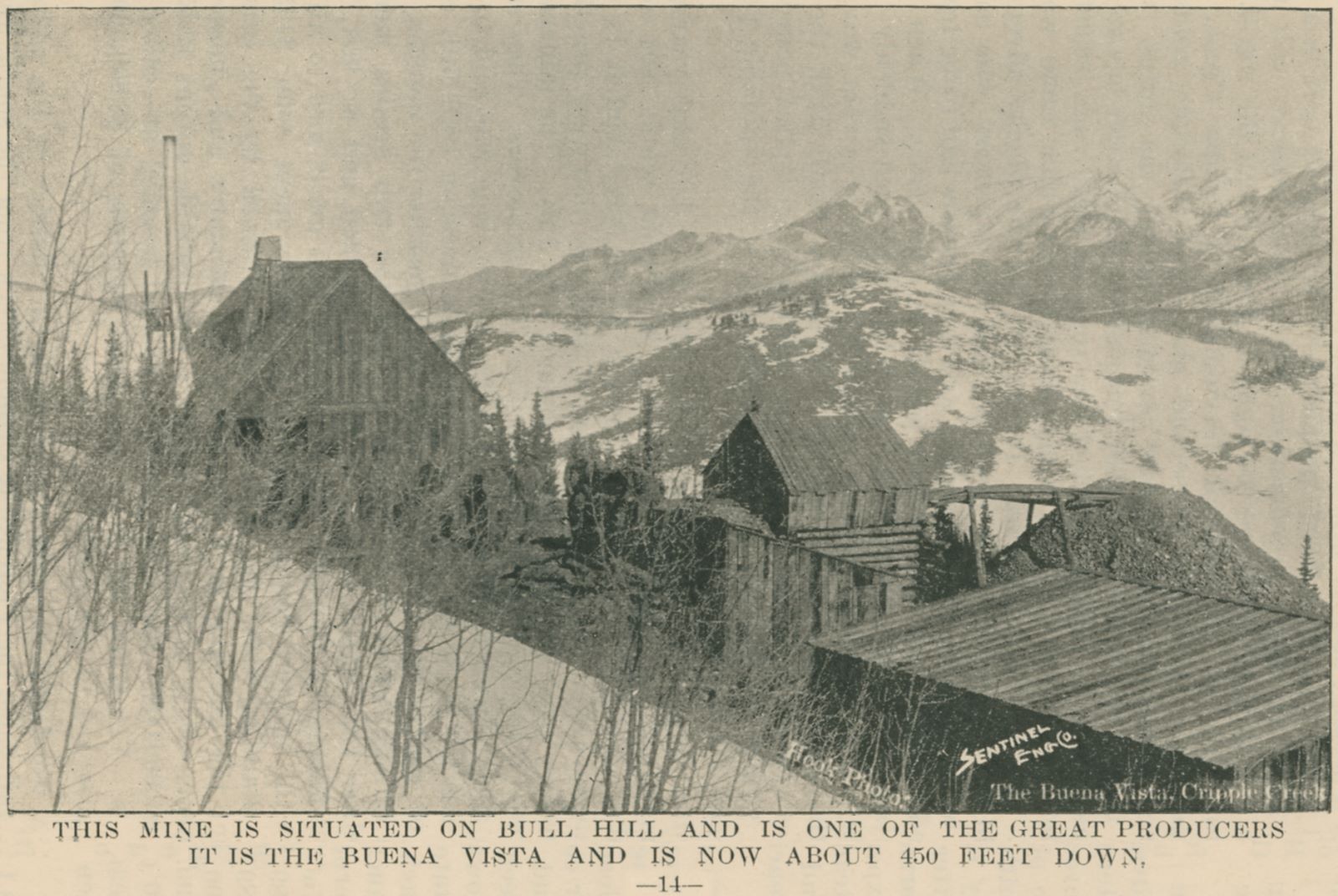
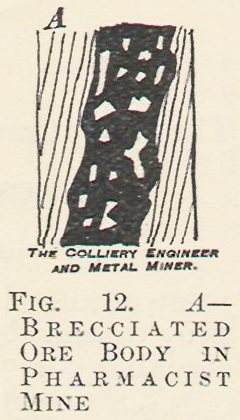
-strght-enhanced-colored.jpg)
